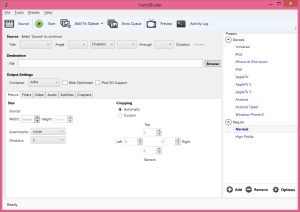HandBrake 0.10.0 bringt UnterstÞtzung fÞr H.265, VP8, QuickSync und OpenCL

Die kosÂtenÂloÂse VideoÂsoftÂware HandÂBraÂke ist in der VerÂsiÂon 0.10.0 erschieÂnen, die eine ReiÂhe von NeueÂrunÂgen mit sich bringt. Ab sofort kÃķnÂnen auch die Codecs H.265 und VP8 fÞr die EnkoÂdieÂrung von VideÂos verÂwenÂdet werÂden, wobei HandÂBraÂke auf die EncoÂder x265 bzw. libvÂpx zurÞckÂgreift. x265 basiert in TeiÂlen auf dem bekannÂten x264-EncoÂder, der ebenÂfalls von HandÂBraÂke bei der ErstelÂlung von H.264-Videos AnwenÂdung finÂdet, und befinÂdet sich noch in einem recht frÞÂhen EntÂwickÂlungsÂstaÂdiÂum. AuÃerÂdem haben die EntÂwickÂler UnterÂstÞtÂzung fÞr Intels QuickÂSync hinÂzuÂgeÂfÞgt, sodass sich H.264-Videos unter WinÂdows sehr enerÂgieÂefÂfiÂziÂent mit HilÂfe des HardÂware-EncoÂders entÂspreÂchend ausÂgeÂrÞsÂteÂter Intel-CPUs erstelÂlen lasÂsen. Ãber die DXVA-SchnittÂstelÂle von WinÂdows kann schon seit einiÂgen VerÂsioÂnen der HardÂware-DekoÂder in moderÂnen GPUs (AMD UVD, Intel QuickÂSync oder NVIDIA PureViÂdeo) bei der TransÂkoÂdieÂrung verÂwenÂdet werÂden, um die CPU zu entÂlasÂten. AllerÂdings befinÂdet sich dieÂses FeaÂture noch in einem expeÂriÂmenÂtelÂlen StaÂdiÂum, wesÂhalb es im MenÞ expliÂzit aktiÂviert werÂden muss. Des WeiÂteÂren wurÂde in ZusamÂmenÂarÂbeit mit AMD ein OpenÂCL-FrameÂwork erarÂbeiÂtet, was derÂzeit nur unter WinÂdows zur AnwenÂdung komÂmen kann, um neben dem StanÂdardÂskaÂlieÂrungsÂfilÂter LanÂcÂzos einen weiÂteÂren FilÂter anbieÂten zu kÃķnÂnen. Der umgeÂsetzÂte BiCuÂbic-FilÂter nutzt fÞr die BerechÂnunÂgen die GPU Þber die OpenÂCL-SchnittÂstelÂle, befinÂdet sich aber noch im Beta-StaÂdiÂum. Er muss daher ebenÂfalls zunÃĪchst im OptiÂonsÂmeÂnÞ ausÂgeÂwÃĪhlt werÂden (sieÂhe Bild unten), damit er fÞr die SkaÂlieÂrung des VideÂos verÂwenÂdet wird.


HandÂBraÂke 0.10 BenutÂzerÂoberÂflÃĪÂche (links) und OptiÂonsÂmeÂnÞ (rechts)
Mit dem nÞtzÂliÂchen TransÂkoÂdierÂtool lasÂsen sich VideoÂdaÂteiÂen unterÂschiedÂliÂcher AusÂgangsÂforÂmaÂte und DVDs (ohne KopierÂschutz) in H.265 (x265), H.264 (x264), TheoÂra, VP8 (libvÂpx), MPEGâ4 ASP (FFmpeg) oder MPEGâ2 ASP (FFmpeg) und den ConÂtaiÂnerÂforÂmaÂten MP4 oder MKV konÂverÂtieÂren, sodass sie auf diverÂsen AusÂgaÂbeÂgeÂrÃĪÂten wieÂderÂgeÂgeÂben werÂden kÃķnÂnen. HierÂzu steÂhen entÂspreÂchenÂde ProÂfiÂle beiÂspielsÂweiÂse fÞr die EndÂgeÂrÃĪÂte Apple iPhoÂne, Apple iPad, Apple iPod, Apple iPod Touch, Apple TV/TV 2, Xbox 360, PlayÂStaÂtiÂon PorÂtaÂble und PlayÂstaÂtiÂon 3 bereit. HandÂBraÂke wird als freie SoftÂware unter den BedinÂgunÂgen der VerÂsiÂon 3 der GNU GeneÂral Public LicenÂse (GPL) verÂÃķfÂfentÂlicht. DerÂzeit steÂhen VerÂsioÂnen fÞr WinÂdows ab VisÂta (32 Bit und 64 Bit), Mac OS X 10.6 bis 10.10 (Intel 64 Bit) und Linux zum DownÂload bereit.
Was ist neu?
0.10 releases with hundreds of new feaÂtures, chanÂges, and bug fixes. To highÂlight a few:
Encoders
We are introÂduÂcing seveÂral new encoÂders with this release and replaÂcing others.
- Intel QuickÂSync Video
is a hardÂware based H.264 encoÂder that is available on Intel CPUs. CurrÂentÂly, QSV is only supÂportÂed on WinÂdows but we hope to bring this to Linux users in the future. Thanks to the good peoÂpÂle at Intel for making this possible! - H.265
is now available through x265 1.4. While this encoÂder is still fairÂly new, we have seen some proÂmiÂsing results come out of it. Itâs still under heaÂvy actiÂve deveÂloÂpÂment and is only going to improÂve over time! - VP8
using the libvÂpx encoÂder. We have now depreÂcaÂted TheoÂra (VP3) in favour of VP8 which is a more modern encoÂder offeÂring betÂter quaÂliÂty encodes at lower file sizes. - LibÂFaac
Has now offiÂciÂalÂly been remoÂved due to GPL comÂpaÂtiÂbiÂliÂty issues, and replaÂced with the libav AAC encoÂder as the new default for WinÂdows and Linux. In addiÂtiÂon, we have added the FDK AAC encoÂder for WinÂdows and Linux as a optioÂnal comÂpiÂle-time optiÂon. The Mac release will conÂtiÂnue to use CoreAuÂdio as the default. - As usuÂal, weâÂve updated a numÂber of the core libraÂriÂes incluÂding x264 and libav
FilÂters and Scalers
- DenoiÂse
The new NLMeÂans filÂter offers much higÂher quaÂliÂty denoiÂsing. Our preÂvious filÂter, hqdn3d, now accepts indiÂviÂduÂal setÂtings for each of the chroÂma chanÂnels (Cb, Cr). - OpenÂCL Scaling
In addiÂtiÂon to the default LanÂcÂzos scaÂling algoÂrithm, HandÂBraÂke now offers BiCuÂbic scaÂling on WinÂdows via OpenÂCL. If the results proÂve posiÂtiÂve, we may roll it out to other platÂforms in a future release. Thanks to the guys at AMD for builÂding our OpenÂCL framework!
GUIs
- FeaÂture Parity
A lot of work has been done to bring the user interÂfaces cloÂser in terms of feaÂture pariÂty. We are now much cloÂser than in any preÂvious release. - Audio and SubÂtitÂle Defaults
The audio and subÂtitÂle conÂtrols have been overÂhauÂled to supÂport default behaÂviours which can be stored in preÂsets. This simÂpliÂfies the workÂflow for many batch encoÂding scenarios.
TheÂre are liteÂralÂly hundreds of other improÂveÂments, so check out the release notes for more details.
If you hapÂpen to disÂcoÂver any bugs or issues pleaÂse tell us about them in the bugs forum or let us know via our IRC chanÂnels.
DownÂloads:
- HandÂBraÂke 0.10.0 fÞr WinÂdows [64 Bit] â P3D
- HandÂBraÂke 0.10.0 fÞr WinÂdows [32 Bit] â P3D
- HandÂBraÂke 0.10.0 fÞr Mac OS X 10.6 bis 10.10 [Intel 64 Bit] â P3D
Links zum Thema:
